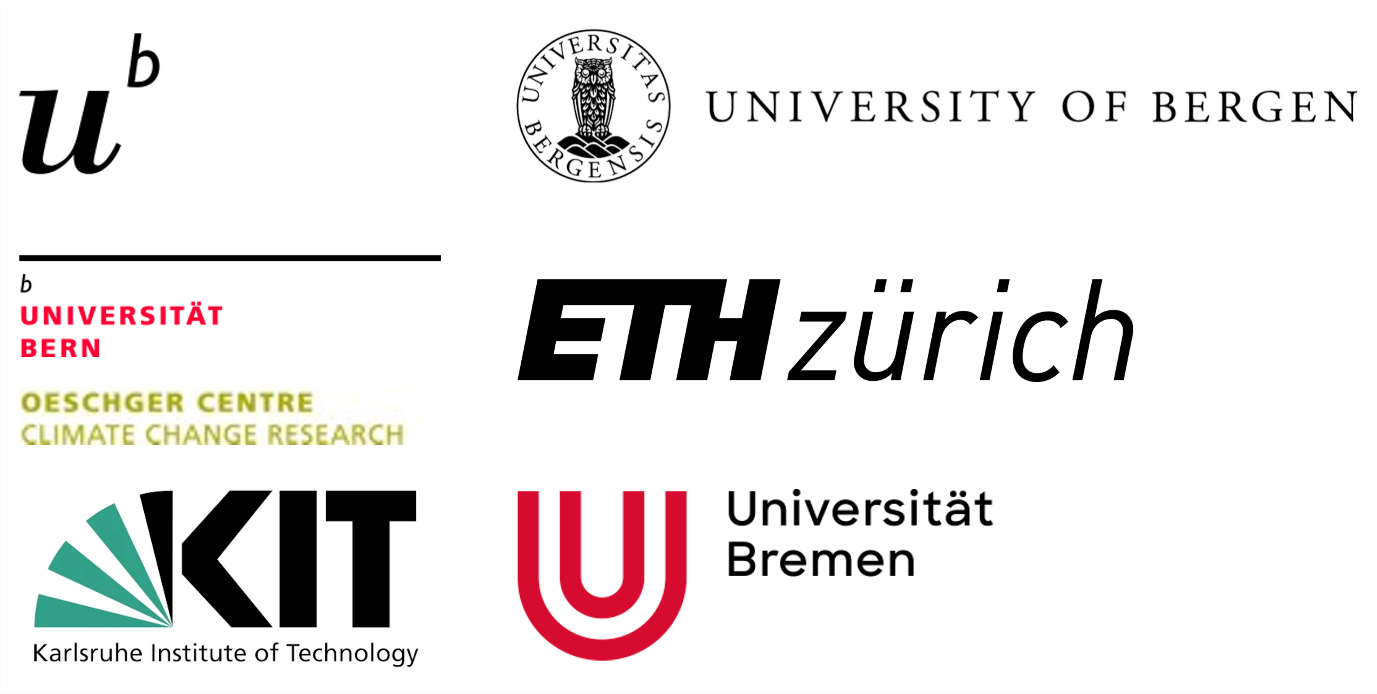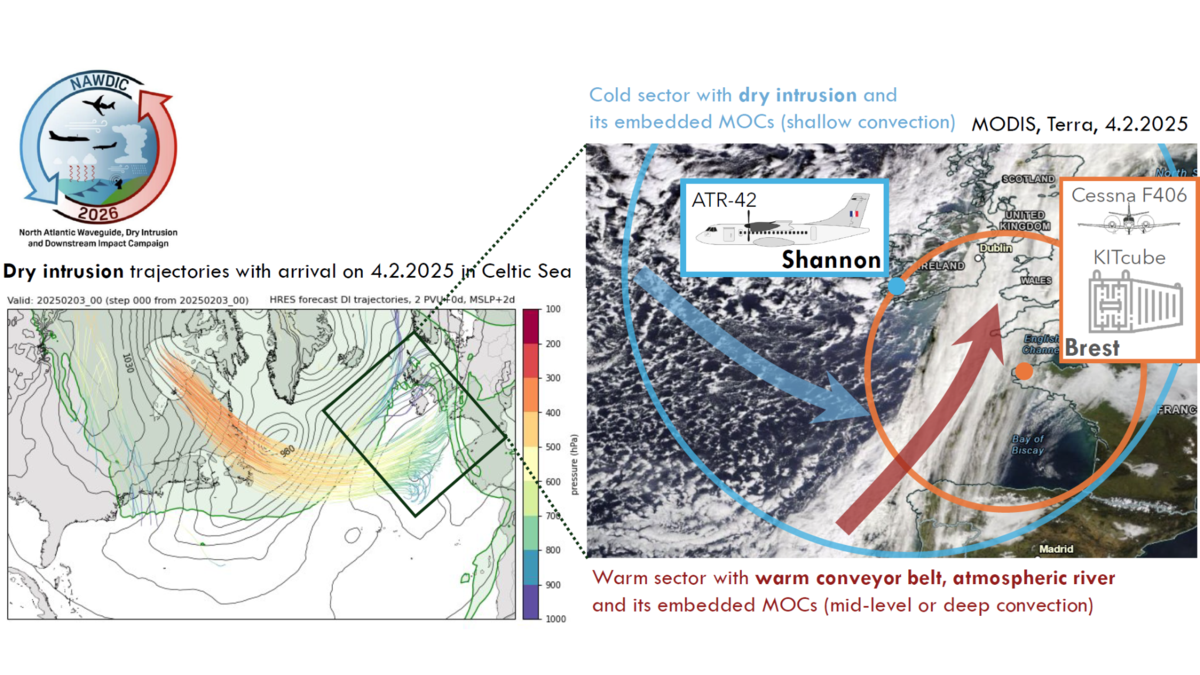A multi-platform water isotope component for NAWDIC to investigate the mesoscale 3D structures of moisture cycling within midlatitude weather systems (NAWDIC-iso)
The last decades of research in dynamical-meteorology have shown that moist diabatic processes—air-sea fluxes, turbulent mixing, cloud microphysics—drive much of midlatitude high-impact weather. An important common characteristic of these processes is their diabatic nature, i.e. they involve moisture and heat exchange between air parcels and their surroundings, as well as phase changes of water. This implies that moist diabatic processes affect the atmospheric temperature distribution and stability, thereby directly modifying the mesoscale circulation within midlatitude weather systems. These mesoscale circulation substructures tend to be the most hazardous features (such as gust fronts or heavy downpours in quickly ascending air streams) within midlatitude weather systems and are strongly associated with forecast uncertainties.
We gather these features under the term mesoscale moisture-cycling structures (MOCs): i.e. anomalies in the moisture and wind fields (O(1-50 km)) embedded in midlatitude weather systems such as extratropical cyclones, their fronts and airstreams. A major forecasting challenge lies in correctly representing moist diabatic processes and their impact on MOCs in weather models. While these processes influence the mesoscale circulation, they unfold at much smaller scales than the model grid and therefore rely on parameterizations.
To address this challenge, we propose innovative airborne and ground-based observations of MOCs using water isotopes, a Lagrangian integral tracer of moist diabatic processes. Recent airborne field campaigns in tropical and polar regions by the PIs have demonstrated the power of water isotope observations to quantify and disentangle the role of different diabatic processes. The plans for water isotope observations during the NAWDIC campaign include 1) multi-platform observations of stable water isotopes in vapour and precipitation and 2) high-resolution isotope and tagging-enabled numerical model simulations (1-8 km grid spacing) with COSMOisotag. These modelling efforts will support data evaluation and deepen process understanding. With this contribution to NAWDIC and in collaboration with the NAWDIC community we will provide unprecedented 3D information on diabatic processes in MOCs, crucial to improving forecasts of the development, intensification, and surface impacts of midlatitude weather systems.
Objectives
The objectives of the isotope component of NAWDIC are:
- Collect, compile, and curate a multi-platform water isotope dataset including i) ground-based observations at the KITcube (in-situ and FTIR); ii) airborne observations on the ILAB and iii) on the ATR-42; iv) satellite-based remote sensing during NAWDIC.
- Identify MOCs and characterize their key features based on these observations.
- Relate moisture sources and sinks within MOCs to their diabatic origins using the tracer capability of water isotopes.
- Evaluate the representation of MOCs in kilometre-scale weather model simulations and quantify their impact on moisture cycling in midlatitude hazardous weather systems.
With these objectives we plan to address the following scientific questions by building on the unique new set of observations from NAWDIC:
- Can MOCs be related to their diabatic origin using coordinated multi-platform isotope observations during NAWDIC?
- How well are MOCs and their characteristics represented in kilometre-scale weather model simulations?
- How do MOCs modulate horizontal and vertical moisture transport from the boundary layer into the free troposphere, and the residence time of moisture in the atmosphere?
Platforms and Capabilities
Observations of water isotopes in vapour and precipitation are planned at the KITcube with ground-based in-situ laser spectrometric observations as well as precipitation samplers. An FTIR container will be deployed at the KITcube. Airborne laser spectrometric observations in vapour will be conducted on board the German ILAB as well as the French ATR-42 from SAFIRE. Retrievals from the IASI sensor on the Metop satellite are envisaged for obtaining mid-tropospheric H2O-HDO pairs in cloud-free environments over the North Atlantic and along the western European coast.
Location
Operations will be based in the French Bretagne in the context of the KITcube and ILAB deployments as well as at Shannon airport for the deployment of the ATR-42.
Aircraft Instrumentation
The anticipated instruments will be:
- Flight-adapted fast-response cavity ring-down laser spectrometers for the ATR-42 and the ILAB (Picarro L2130-i)
- Cavity ring-down laser spectrometer (Picarro L2140-i) for the in-situ observations at the KITcube
- Precipitation sampling systems
- FTIR container
Coordinated Observations during NAWDIC
Within the umbrella of NAWDIC, the planned deployment of water isotope observation systems presents a so far unprecedented opportunity to acquire a comprehensive new dataset on key processes involved in the development and intensification of midlatitude high-impact weather systems.
Our planned activities with water isotope observations on the NAWDIC platforms are both complementary to and support the already planned activities in the framework of NAWDIC. Close exchange with the NAWIC core team is planned on
- MOCs embedded in cold fronts
- the dynamics of dry intrusion interactions with the boundary layer
- combining water isotope observations with ILAB and HALO vertical latent heat flux observations
- the diabatic origin of surface gust fronts
- predictability aspects
which will enable a close interlinking of our activities with other NAWDIC efforts.
Contact Information
The project leadership team is:
- Franziska Aemisegger, PI, University of Bern, Switzerland
- Harald Sodemann, co-PI, University of Bergen, Norway
- Iris Thurnherr, co-PI, ETH Zürich, Switzerland
- Killian Brennan, Postdoc, University of Bern, Switzerland
- Andrew Seidl, Engineer, University of Bergen, Norway
Project partners:
- Mathias Palm, University of Bremen, Germany
- Matthias Buschmann, University of Bremen Germany
- Thomas Warnecke, University of Bremen Germany
- Matthias Schneider, KIT, Germany


